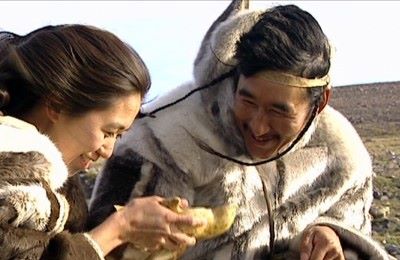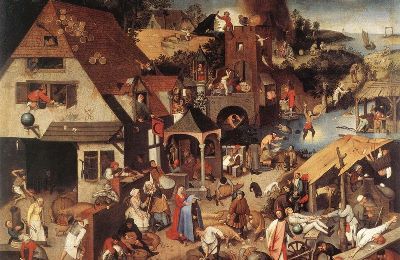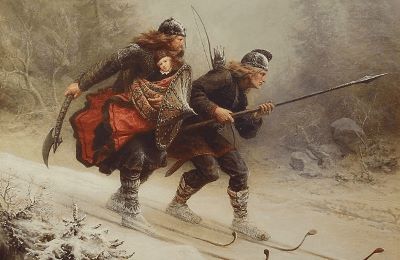
|
Love! Most people around the world know that the day of love and lovers is Saint Valentine's Day, on February 14th. On this day, people express their love for special people in their lives in various ways. But who was this Saint Valentine, and why is he so linked to love? It is common for the Christian church to set aside days to celebrate specific saints for their actions. In this case, there were at least three saints named Valentine, all martyrs (people who have died for a particular cause) and all dying on February 14th. The first was Valentine of Rome who was a priest in Rome, killed around 269 AD, and buried on the Via Flaminia. His flower crowned skull is on exhibit in the Basilica of Santa Maria in Cosmedin, Rome. The second was Valentine of Terni who became a bishop then a martyr during the rule of Emperor Aurelian. He was also buried on the Via Flaminia but in a different location, and his relics are at the the Basilica of Saint Valentine in Terni. The third Valentine was martyred in Africa, but little else is known of him. ...it had become a common practice in England to give gifts and exchange handmade cards on Valentine's Day. In the official church biographies of these saints, there are no romantic attachments, and by the time anything involving romance was linked to Saint Valentine in the fourteenth century, any distinction between which Valentine was involved was lost. Saint Valentine's head was preserved and respected in the abbey of New Minster in Winchester, England, but no celebrations for him differed from any other celebration of other saints. Legends  Painting of St. Valentine kneeling by David Teniers III Historical research has most scholars believing that Saint Valentine was a priest near Rome around 270 AD, a time when the church was under persecution by the Roman Emperor Claudius II. Many priests worked to help Christians escape persecution as well as provide them with basic sacraments (a sacred rite recognized as of particular importance and significance) such as marriage, which was outlawed during this time. More information than that, however, becomes mixed with myth and legends. In the 6th century, a story by Passio Marii et Marthae was published telling of the martyrdom of a Saint Valentine of Rome. It states that Valentine was caught and interrogated by Emperor Claudius II personally. Claudius is said to have been impressed by Valentine and tried to convert him to Roman paganism in exchange for his life. Valentine refused, however, and instead tried to convert the emperor to Christianity. For this impunity, we was sentenced to be executed. While awaiting his execution, he supposedly performed a miracle by curing the blind daughter of his jailer. When he did this, the jailer, his daughter, and forty-six other people came to believe in Jesus and were baptized. Another part of the legend is that on the night of his execution, Valentine sent the daughter a letter and signed it "from your Valentine". A further legend is that while having illegal weddings for other Christians, Valentine reportedly cut small hearts out of parchment and gave them to the persecuted Christians as a reminder of God's love. Lupercalia There was an archaic pagan rite associated with fertility and love called Lupercalia which was celebrated on February 13-15 until it was abolished by Pope Gelasius around 492 AD. Although there is no historical facts connecting this with Saint Valentine's day, many people do believe they are related. Chaucer  So when and why did Saint Valentine become associated with love? The first recorded connection came from a poem by Geoffrey Chaucer in 1382 named "Parlement of Foules". The primary verse which addresses this was: For this was on seynt Volantynys day For those whose Old English is a bit rusty, it translates to "For this was on Saint Valentine's Day, when every bird cometh there to choose his mate.".  Man and woman with Valentine’s Day gifts The poem was in honor of the first anniversary of the engagement of King Richard II of England to Anne of Bohemia. The reference to Saint Valentine's day connects this celebration of love along with that of couples finding their mates. However, some scholars have pointed out that February is too early a time for birds to be mating and that the day in question might be referring instead to May 2nd, which is the celebration of Valentine of Genoa who was a bishop that died around 307 AD. Regardless, the connection along with the previously mentioned legends and the date of Lupercalia have all helped to solidify Saint Valentine's Day of February as a time for lovers and loved ones. French and English literature of the fourteenth century talks about the practice of lovers using this day to exchange special love letters and tokens. In the following centuries the holiday evolved and by the 18th century, it had become a common practice in England to give gifts and exchange hand-made cards on Valentine's Day. This eventually spread to the American colonies, then to other countries. |
|
Celebrations Around the World  Shop with Valentine's Day gifts In the United States of America, Valentine's Day is very popular as well as heavily commercialized. The most common tradition is to exchange cards expressing love or even the common "Valentine" which is a specialized card. A Valentine also refers to the person giving or receiving the card, so these cards normally carry the phrase "Please be my Valentine". The exchanging of valentines is very popular among children during classroom parties in their schools. Simple poetry is often exchanged as well, with the most common lines to begin it being "Roses are red, Violets are blue". As part of the commercialization, small gifts are also exchanged. The most common of these are roses and chocolate given to women by men, but everything from stuff animals to diamond jewelry is also given. The reference to "love" has also been expanded to include both the platonic love between friends to the intimate kind between spouses and lovers. Special dances and dinners are also organized for lovers to spend time together. In Britain, the exchange of cards and gifts is done like in the US, but children also sing special songs related to the occasion for which they are rewarded with candy, fruit, or even money. Composing poetry is also done at a much greater level than in the US, especially since the first romantic poetry associated with Valentine's Day was written in Britain. The English also bake special "valentine buns" as a means of celebrating fertility.  Valentine postcard, circa 19001910 Valentine's Day was once celebrated as an open air Spring Festival in Italy, but it hasn't been celebrated like that for centuries. Instead, it is now treated as other holidays imported from the US, like Halloween, and is celebrated mainly by young people in the same way as the US. However, it is more designated toward lovers, and so family members and friends do not normally exchange gifts. One aspect of this holiday that Italy and Britain shared was that unmarried girls were supposed to wake up before sunrise and stand by their windows, for it was believed that the first man an unmarried girl sees on Valentine's Day would marry her within a year. The French once had a Valentine custom called "drawing for". It involved unmarried individuals to enter houses which faced each other and calling from one window to the other, pairing off with a chosen partner. If the male was not very happy with his "drawn" valentine, he would leave her. At the end of the day, a bonfire was lit so that the rejected women could burn images of the ungrateful man and verbally abuse him aloud. Due to the amount of nastiness this custom caused, however, the French government finally banned it. In modern France, they celebrate this day by the exchange of cards and gifts as in other countries. In Germany, the custom is that the man of an unmarried couple presents his beloved with flowers on February 14th. Gifts and messages are also exchanged, but these are not restricted to Valentine's Day and can be given on any joyous occasion.  A special card is used in Denmark called a "lover's card". Earlier versions of these were transparent and when held up to light showed the image of a lover handing his beloved a present. Now, any Valentine's Day card is called a "lover's card". Another tradition the Danish practice is the sending of pressed white flowers called Snowdrops to their friends and loved ones. Like Italy, however, Valentine's Day is generally viewed as being for the young, between the ages of 15 and 30. In Japan, Valentine's Day is actually broken into two different dates. On February 14th, women give gifts to the boyfriends, spouses, lovers, or any many close to them. This is then rewarded on White Day, March 14th, when the men who received such gifts then pamper the women who gave them. Chocolate giving from women is a very strong custom on these days. Women give close male friends and bosses "giri-choco" but it has no romantic association. "Giri" means "obligation" and women make sure to gift all men close to them with this since it is embarrassing for a man to not receive any. For boyfriends, lovers and husbands, "hon-mei" is given. Many women even feel that it isn't true love if this chocolate is bought, so they prepare them personally. "Hon-mei" means "prospective winner", so any man receiving these feels very lucky. The Koreans share the same tradition of splitting Valentine's Day and exchanging chocolates, with one notable exception. On the "White Day", many men confess their love for the first time to their valentines. For those people that have no particular romantic partners or interests, there is a third date set aside. On April 14th, or "Black Day", these people get together and eat Jajang noodles, which are black.  One custom in Scotland is to gather an equal number of unmarried men and women and have them write their names on pieces of paper which are then placed in two hats, one for men and one for women. The women then draw the names of men and the men draw the names of women, as a means of creating couples. However, since it is very unlikely that any of these names would match correctly, if they don't, the male would go with the female that selected his name. Gifts are then given to the women, and those women pin the name of their partner to their clothes, either over the heart or on their sleeves. This is often followed by a dance and sometimes, at the end of the festival, some marriages take place. These are just some of the ways Valentine's Day is celebrated around the world. More countries have begun to celebrate it in recent years, adopting the US and British ways of exchanging gifts and cards as well as creating their own traditions. Be sure to spend time with your loved ones this Valentine's Day! |
| Celebrations - Valentine's Day | ||||||||||||||
| Writer: | Sonja Krüger | |||||||||||||
| Images: | ||||||||||||||
| ||||||||||||||
| Sources: | ||||||||||||||
| ||||||||||||||
All images are Copyright - CC BY-SA (Creative Commons Share Alike) by their respective owners, except for Petey, which is Public Domain (PD) or unless otherwise noted.
|
Looking for learning materials? Scriveremo Publishing, has lots of fun books and resource to help you learn a language. Click the link below to see our selection of books, availlable for over 30 langauges!
| |
comments powered by Disqus













































